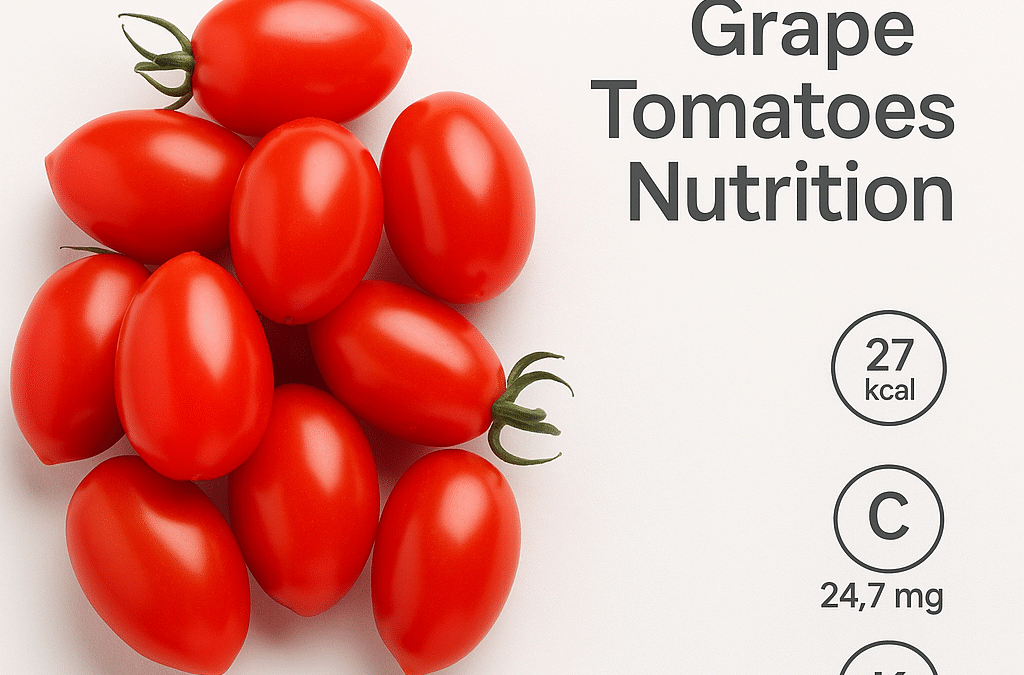Disclaimer
Nutritional values are approximate and may vary based on growing conditions, ripeness, and serving size. This article is for educational purposes only and not a substitute for professional dietary advice.
Small, vibrant, and naturally sweet, grape tomatoes are one of the most convenient and nutrient-rich fruits you can add to your meals. Whether tossed in salads, roasted with olive oil, or eaten as a snack, these tiny red gems deliver impressive nutrition in every bite.
Understanding grape tomatoes nutrition helps you see how something so small can have such a big impact on health — offering antioxidants, vitamins, and hydration while being remarkably low in calories.
What Are Grape Tomatoes?
Grape tomatoes are a smaller, thicker-skinned variety of tomatoes that resemble grapes in size and shape — hence the name. They are typically sweeter and firmer than cherry tomatoes, with a longer shelf life and less water content.
Originally cultivated in Southeast Asia, grape tomatoes have become popular worldwide due to their:
- Crisp bite and balanced sweetness
- Resistance to bruising and spoilage
- Versatility in both raw and cooked dishes
Unlike larger tomatoes, they’re perfect for snacking and portion control, while still offering the full range of tomato health benefits.
Grape Tomatoes Nutrition Facts (Per 100 g / About 10 Grape Tomatoes)
| Nutrient | Amount |
|---|---|
| Calories | 27 kcal |
| Total Fat | 0.3 g |
| Saturated Fat | 0 g |
| Carbohydrates | 5.8 g |
| Sugars | 3.9 g |
| Dietary Fiber | 1.8 g |
| Protein | 1.1 g |
| Sodium | 5 mg |
| Potassium | 360 mg |
| Vitamin C | 24.7 mg (27% DV) |
| Vitamin A | 833 IU (17% DV) |
| Vitamin K | 7.9 µg (10% DV) |
| Folate | 18 µg |
| Calcium | 10 mg |
| Iron | 0.3 mg |
| Magnesium | 11 mg |
| Water Content | ~95% |
DV = Daily Value based on a 2,000-calorie diet.
Calories in Grape Tomatoes
Grape tomatoes are incredibly low in calories — only 27 calories per 100 grams (around 10 tomatoes).
This makes them ideal for:
- Weight management
- Low-calorie snacking
- Hydration during summer months
Their calorie content mainly comes from natural sugars and carbohydrates, but the high fiber and water balance prevent any spike in blood sugar.
Carbohydrates and Sugar
Each 100-gram serving contains 5.8 grams of carbohydrates and 3.9 grams of natural sugar.
These are naturally occurring sugars — not added ones — and are accompanied by fiber and phytonutrients that slow absorption.
Grape tomatoes have a low glycemic index (GI ~15), meaning they release energy slowly and are safe for most people with diabetes when eaten in moderation.
Fiber Content
With 1.8 grams of dietary fiber per serving, grape tomatoes help:
- Promote healthy digestion
- Support gut bacteria
- Reduce hunger between meals
The fiber is primarily soluble, which helps lower cholesterol levels and regulate blood sugar.
Protein and Fat
While grape tomatoes aren’t a protein source, they provide around 1 gram per serving — higher than most fruits.
Fat content is negligible at 0.3 grams, and virtually none of it is saturated or trans fat.
When paired with healthy fats like olive oil or avocado, the fat-soluble vitamins (A and K) in tomatoes are better absorbed by the body.
Vitamins in Grape Tomatoes
Grape tomatoes are packed with vitamins that support immunity, vision, and skin health.
1. Vitamin C:
At 25 mg per 100 g, they provide nearly one-third of your daily needs, helping to strengthen immunity and collagen formation.
2. Vitamin A (as beta-carotene):
Important for eye health, cell growth, and skin repair. The bright red color of grape tomatoes signals their high beta-carotene content.
3. Vitamin K:
Contributes to bone health and blood clotting — one serving delivers about 10% of your daily requirement.
4. Folate (Vitamin B9):
Essential for DNA synthesis and red blood cell formation, especially important for pregnant women.
5. Vitamin E (trace):
Acts as an antioxidant and supports skin protection from oxidative stress.
Minerals in Grape Tomatoes
| Mineral | Function | Amount (Per 100 g) |
|---|---|---|
| Potassium | Regulates blood pressure and nerve function | 360 mg |
| Calcium | Supports bone strength | 10 mg |
| Magnesium | Helps muscle and energy metabolism | 11 mg |
| Iron | Aids oxygen transport | 0.3 mg |
| Phosphorus | Supports cell energy production | 24 mg |
Potassium is particularly noteworthy — a serving of grape tomatoes provides more potassium than many other vegetables, helping balance sodium and support heart function.
Antioxidants and Phytonutrients
Grape tomatoes are loaded with antioxidants, natural compounds that fight oxidative stress and inflammation.
Key antioxidants include:
- Lycopene:
- The red pigment responsible for their color.
- Linked to lower risk of heart disease and certain cancers.
- Becomes more bioavailable when tomatoes are cooked or consumed with oil.
- Beta-Carotene:
- Converted into Vitamin A in the body.
- Promotes healthy vision and immune defense.
- Chlorogenic Acid and Naringenin:
- Help reduce inflammation and protect against oxidative damage to cells.
Eating grape tomatoes regularly provides a steady dose of these compounds that support long-term wellness.
Hydration Benefits
Composed of about 95% water, grape tomatoes are naturally hydrating and refreshing.
They help:
- Maintain electrolyte balance
- Prevent dehydration
- Support digestion and kidney function
Including them in meals or snacks helps boost fluid intake, especially during hot weather or exercise.
Grape Tomatoes and Heart Health
The combination of potassium, lycopene, and fiber makes grape tomatoes particularly beneficial for cardiovascular health.
They help:
- Lower blood pressure: thanks to potassium’s sodium-balancing effect.
- Reduce LDL cholesterol: due to soluble fiber.
- Protect arteries: antioxidants like lycopene prevent oxidative stress on blood vessels.
Regular consumption is associated with a lower risk of stroke and heart disease when combined with an overall balanced diet.
Grape Tomatoes for Skin and Eye Health
Vitamin A and lycopene in grape tomatoes protect against UV-induced skin damage, promote collagen formation, and help maintain smooth, healthy skin.
For vision, the combination of beta-carotene and lutein supports retinal health and helps reduce the risk of macular degeneration.
When combined with healthy fats — like olive oil in salads — these nutrients are absorbed more effectively.
Grape Tomatoes and Weight Management
Low in calories, high in water, and rich in fiber, grape tomatoes are perfect for weight-conscious diets.
Their sweet flavor satisfies cravings without added sugar or fat, and they can replace higher-calorie snacks like chips or crackers.
Including grape tomatoes as part of meals or snacks helps increase volume without significantly raising calorie intake.
How to Include Grape Tomatoes in Your Diet
1. Snack Raw:
Eat them as they are — portable, refreshing, and low in calories.
2. Add to Salads:
Enhance color, flavor, and nutrient density in green or pasta salads.
3. Roast or Grill:
Lightly roasting brings out natural sweetness and enhances lycopene bioavailability.
4. Stir into Soups or Pasta:
Adds brightness and texture while boosting vitamin content.
5. Blend into Salsa or Tomato Sauce:
Create a light, antioxidant-rich condiment.
6. Pair with Healthy Fats:
Combine with olive oil, avocado, or cheese to increase absorption of fat-soluble nutrients.
Storage and Freshness Tips
- Store at room temperature until fully ripe, then refrigerate to extend shelf life.
- Keep away from direct sunlight to prevent over-ripening.
- Avoid airtight containers that trap moisture — this can make tomatoes lose flavor and firmness.
- Wash right before eating, not before storing, to prevent mold or spoilage.
Fresh grape tomatoes typically last up to 10 days in the refrigerator.
Grape Tomatoes vs Cherry Tomatoes
| Feature | Grape Tomatoes | Cherry Tomatoes |
|---|---|---|
| Shape | Oval, grape-like | Round |
| Taste | Sweet, less watery | Juicier, more tangy |
| Texture | Firm skin, longer shelf life | Softer skin, shorter shelf life |
| Calories (per 100 g) | 27 kcal | 30 kcal |
| Vitamin C | Slightly higher | Slightly lower |
| Use | Snacking, roasting | Salads, sauces |
Both are healthy choices, but grape tomatoes are favored for snacking and longer storage.
Health Benefits Summary
- Low-Calorie Snack: Only 27 kcal per 100 g.
- Rich in Antioxidants: Lycopene and Vitamin C help protect against chronic diseases.
- Heart Health Support: Potassium and fiber promote healthy blood pressure.
- Skin and Eye Protection: Vitamin A and carotenoids nourish tissues and vision.
- Hydration and Digestion: High water and fiber support gut health.
Potential Drawbacks
- Acidic Nature:
People with acid reflux or sensitive stomachs may experience mild discomfort when consuming large amounts. - Pesticide Residue:
As with most fresh produce, wash thoroughly or choose organic to minimize exposure. - Low Protein and Fat:
Grape tomatoes should be part of a meal, not the entire source of nutrition, since they lack macronutrient balance.
Quick Recap of Grape Tomatoes Nutrition
| Nutrient | Value (Per 100 g) |
|---|---|
| Calories | 27 kcal |
| Carbohydrates | 5.8 g |
| Sugars | 3.9 g |
| Fiber | 1.8 g |
| Protein | 1.1 g |
| Fat | 0.3 g |
| Potassium | 360 mg |
| Vitamin C | 24.7 mg |
| Vitamin A | 833 IU |
| Water Content | 95% |
The Bottom Line
Grape tomatoes are proof that big nutrition can come in small packages.
Low in calories and bursting with antioxidants, vitamins, and hydration, they’re a powerhouse addition to nearly any diet.
Whether you enjoy them raw, roasted, or tossed into salads, they support heart health, skin vitality, and digestive balance — all while satisfying your sweet-savory cravings naturally.
Simple, colorful, and full of life — grape tomatoes are one of nature’s most perfect bite-sized foods.

